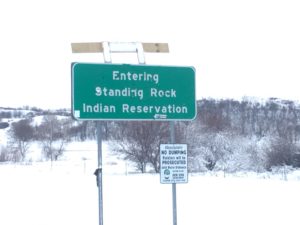 Dear Friends: On Sunday, December 18, 2016, this report on my brief visit to Standing Rock will be featured in the Tallahassee Democrat. I’ll be sharing Part 2 of what I learned at Standing Rock after the holidays.
Dear Friends: On Sunday, December 18, 2016, this report on my brief visit to Standing Rock will be featured in the Tallahassee Democrat. I’ll be sharing Part 2 of what I learned at Standing Rock after the holidays.
During the first week of December, I traveled with my niece Erin Canter to a snowy, stinging cold North Dakota prairie south of Bismarck, where encampments at Standing Rock have evolved into the longest running protest in modern history.
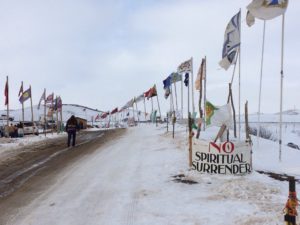 In a moving, historical first, representatives of every tribe on this continent gathered to support the Sioux nations in their struggle to protect the sacred waters of the Missouri River, drinking water source to 15 million people.
In a moving, historical first, representatives of every tribe on this continent gathered to support the Sioux nations in their struggle to protect the sacred waters of the Missouri River, drinking water source to 15 million people.

Oceti Sakowin camp, one of several sites where “water protectors” have taken a stand, vowing to protect the river they know to be sacred.
Oceti Sakowin and several satellite camps sit on Federal lands that legally belong to the Standing Rock Sioux under the terms of an 1851 treaty. On that site, thousands of Native Americans and their allies are seeking to halt completion of the 1172-mile Dakota Access pipeline, which is intended to transport fracked oil from the Bakkan shale oil fields of North Dakota, to southern Illinois. The concern about an oil spill upriver from the tribe’s water source has resonated with groups across the country.
Like so many others, in the days after the devastating November election, I searched for a larger context of hope, and for personal direction. I asked Tallahassee-born Caitlin McMullin, who had just spent 7 days at Standing Rock with her 3-month old baby boy, Should I go, do you think I could be helpful? ABSOLUTELY! she messaged in return.
So, Erin and I bought plane tickets and flew to North Dakota. We went because what is happening on the banks of the Missouri River and all along the pipeline path is a one-sided war. We went to witness, to learn, and to work. With us we brought $4000 in cash contributions from big-hearted friends (our neighbors in Indianhead Acres, members of the Tallahassee Area Threshold Choir, and folks at Uptown Café were particularly generous). We also shipped out two enormous boxes of wool clothing.
It took several hours to drive the 50 miles from Bismarck to Standing Rock. The road was marbled with gray ice and biting snow flurries. We had filled our rented vehicle with drinking water; medical supplies; snow shovels, kitty litter and tow straps (should we get stuck); Visa cards; meat and fresh vegetables. I felt scared: we’d been told that illegal road blockades manned by county and state police would turn back or heavily fine anyone delivering supplies to the camp. We hid our contributions under our own luggage, hoping we wouldn’t be stopped. We’d heard that tensions were escalating, since the Army Corps of Engineers had set a deadline of December 5 to close down the camps. We’d also heard that several thousand veterans and nearly as many clergy were coming to Standing Rock on Sunday to stand by the people. That news gave us courage.
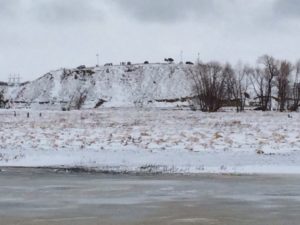
The violence was largely over by the time we arrived. Still, the presence of police across the river from the camp, along the pipeline route, was deeply disturbing.
We knew we’d reached Oceti Sakowin when we spotted floodlights tall as cell towers skewering the sky along the ridge where the pipeline is intended to cross the river. At the gate, a young man greeted us and told us where to deliver our donations.
I wandered around the camp, watching people build yurts and hammer together plywood bunkhouses. There were at least seven communal kitchens which offered volunteers everything from plain bologna sandwiches to stews and salads, and served as sleeping spaces beginning at 10 PM each night. I felt overwhelmed, picking my way along icy paths that threaded between of dozens of tents twisted and crushed by snowstorms and heavy wind. The camp felt so at risk and impermanent, and yet the people I met seemed cheerful and engaged.
Propane was in high demand at the camp, and firewood, because the local law enforcement had blocked the main access road to the camp. But all kinds of folks were hauling in whole trees to be cut up for wood fires, and a full-sized propane truck had managed to pick its way in from somewhere.
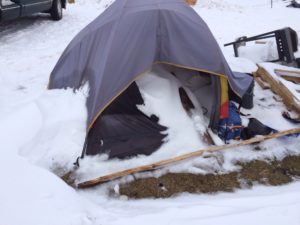
Why we didn’t camp.
People were heating their yurts and tepees and army tents and little plywood structures with wood stoves–you simply couldn’t camp without one, we were told. Erin and I had come equipped with subzero sleeping bags and a borrowed four-season tent, but our gear was no match for the bitter temperatures. We were cautioned not to sleep in our car, either; we were lucky to crash with friends in the closest and only hotel, the filled-to-bursting Standing Rock Prairie Knights Casino.
That first morning I came upon Oceti Sakowin’s main sacred fire, which had been tended and kept burning since late summer. Under a small plywood shelter, a band of Lakota drummers and a kind-voiced elder kept a continuous thread of amplified verbal contact with the crowd.
“My relatives,” the elder began, and then he announced the needs of the moment: a ride to Bismarck for two young people; cooks for one or another of the kitchens; six tepee poles for some young women who’d arrived with canvas but no poles. Amongst all the cold and the rugged conditions and an unknown future, the warm voice of the leader brought us into the needs of the present.
At one point, the elder’s voice deepened with emotion. “My relatives,” he said. “We need to offer a special welcome to a young veteran who has just arrived here on foot from Oklahoma. He walked all the way here to help protect us!” The man’s voice broke over the mike.
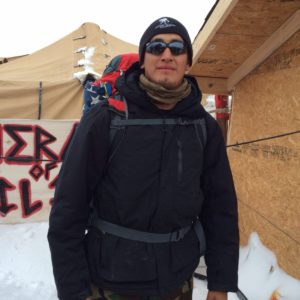
Chris Turley, Native veteran. Taken with his permission.
The young veteran stood before us, straight-backed and open-faced. I was standing close enough to see his lips tremble. Any mother of any tribe or race would have recognized the courage of this son, this warrior, this father of daughters.
A tin can with a makeshift wire handle was procured, and before any more words were spoken, Chris Turley, a member of the Osage Nation in Oklahoma who had served in the U.S. Army for nine years, was ceremonially blessed with burning cedar chips and sage.
The Sioux elder passed the microphone to Chris.
“I’ve come here because of the vow I made when I entered the armed services, which was to protect our country from both foreign and domestic threat/terrorism,” he said.
None of us missed his emphasis on the word “domestic.” Especially because just at that moment, a yellow corporate helicopter from Energy Transfer Partners (the company building the Dakota Access Pipeline) buzzed directly over us. Chris inclined his head skyward. Every one of us recognized it for what it was: domestic terrorism.
Contemplating this young warrior’s courage, we cried. We hugged him, dozens of us. I believe he felt deeply welcomed.
Chris Turley’s arrival marked a surge of military veterans who came to give occupiers a respite and call attention to human rights violations committed by militarized law enforcement. For months, participants in nonviolent prayer marches and actions had been met with road blockades, illegal eviction notices, arrests, tear gas, rubber bullets, attack dogs and water cannons.

Some shelters worked better than others under blizzard conditions. I loved this tiny house equipped with solar panels.
Each day of our visit we attended orientation meetings. Many hundreds of young people, veterans, clergy and others crammed into long army tents and were reminded that we were there to pray, and in no way to bring violence to the pipeline protest. We were asked to be mindful of our status as “allies,” that this was a Native struggle, and that their thinking needed to always be central. We were reminded that, as white people, many of us don’t realize how often we place ourselves front and center (which perpetuates colonization).
At Standing Rock, I had a crash review of the true history of our country. “Your first task is to learn about Federal Indian policies,” a Navaho grandmother told us. Erin and I studied Roxanne Dunbar-Ortiz’ award-winning “An Indigenous Peoples’ History of the United States,” a very readable book that will turn your head round right.
We were forced to confront (me at age 64! finally!) the truth that all of us whose ancestors came to this continent from Europe are “settler-colonialists.” That’s not what I was taught in public school, in the 50s and 60s.
All of my life I’ve worked on behalf of the natural world. Always, I’ve been drawn to this question: Why is it so hard to protect non-human species and natural landscapes, when we love them so very much? From the moment our Europeans forebears set their sights on this continent, it was all about the theft of the land, the taking of resources, and the genocide of the indigenous nations. From the vantage of Standing Rock, I could see that the mindset we inherited and the policies that drive the destruction of Earth are visibly and unmistakably still at work. But I also saw plain as day, how people can confront those ways of taking with love, prayer, and presence.

I was so lucky to share this experience with my niece, Erin Canter!
And, I was reminded that we have entered a time when we can no longer count on politicians or the government to protect our life-giving planet Earth. The new president and his Cabinet intend to sacrifice our climate, our public lands, women’s reproductive rights, civil rights, and affordable health care. Every single one of us needs to step up our game, our activism. Like the tribes at Standing Rock, we can begin by viewing ourselves less as protestors and more as protectors.
Share On:
Sue,
I am in awe of your passion and courage–and shamed by my lack of same!
You go girl!
Coach
Jim, no comparisons needed. We are on the same team, same courage, same passion…
thank you Susan and Erin. You are brave and fearless souls.
Sue, Thank You for your courageous heart. We have so much to learn from our First Nation brothers and sisters. I pray I have the willingness to listen and respond as a protector. I pray we all do.
Your account brought me along with you. Thank you for your beautiful sharing of the essence of your experience.
Wonderful, humble narrative, Susan. Thank you for passing on to us so well the wisdom you gained; deeply moving.
It was a great honor to share this journey with you, to stand with the Water Protectors, bear witness to the efforts of thousands of people under the most difficult conditions, to pray in the cold and to sit in council together afterwards. This is a true and beautiful piece, Susan, that reflects the meaning and impact of Standing Rock. We, colonists-settlers, come and go from Standing Rock, but the Native people are committed to stopping the black snake and protecting the waters. After we left the temperatures plummeted but this didn’t stop the 2,000 veterans from coming, from apologizing on bended knee to the Native people for centuries of genocide against them and the earth. Though you and I are not literally standing behind the Water Protectors now, we are all called to continue to stand behind them, to risk with them whatever is required on behalf of the waters everywhere and the ancestors. I understand that the struggle for the waters is expanding to stop the black snake everywhere, including Florida. So the cry we heard again and again will resonate where you are: Mni Wocini – Water is sacred.
Thank you Susan for your valuable sharing! And your commitment as a protector.
Freddie, thanks for all you do as well…you are a touchstone for me.
Deena, always, always an honor to travel and pray with you. Thank you for leading all of us in thoughtful actions, and stillnesses, in search of wisdom and healing in the world.
Irene, not fearless, just willing!
Jen, you will. You do.
We began learning together on this beautiful planet, didn’t we?